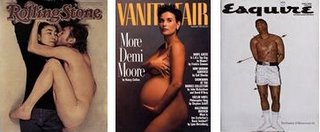
Getting together after the panel talk, Dec. 21, 2005: (Bottom Row L-R): Raymond Virata, Al S. Perez (Middle Row): Gloria G. Galang, Bren Bataclan, Estela Manila, Gerard Talampas (Top Row) John "Spike" Lomibao, Eduardo Datangel, Alberic Rivera
We would like to thank everyone who joined us for our panel talk and reception! We're looking forward to seeing you again at our next show!
P3 Opening Statement (Dec. 21, 2005) by John "Spike" Lomibao
P3: Our Ongoing Journey in Pilipino Design Aesthetics
A diverse collection of graphic and fine art, “P3” seeks to provide snapshots of evolution in the artistic journeys of 6 creatives. Third in a series observing common themes found in Pilipino American design, this exhibit furnishes additional material from which one can gain further insight into the basic attributes of the design aesthetics.
Pilipino design aesthetics are not subtle. The colors are often loud, the hierarchy not so obvious, and it appears much more organic or hand done. At first glance, it may seem too busy. It is quite different than a minimalist Swiss design. Surprisingly, given time and careful examination, the aesthetics become identifiable and begin to make sense. Reflecting life driven by necessity, the overall Pilipino look-and-feel is the product of the challenges and promises of an emerging country. The cultural vibrancy of the Philippines can be attributed to its numerous influences of other cultures over the centuries, including Spanish, Chinese, and Japanese.
American aesthetics with respect to design also reflect themes experienced by its people: freedom, diversity, opportunity, multiculturalism. Coupled with Pilipino sensibilities, these themes give rise to a new and distinctive aesthetic starting with ethnic roots and ending in something quite different than either culture by itself.
For the Pilipino American designer, the fusion of both cultures often brings about an interesting work ethic: it is a circuitous oscillation between stability and clutter, but the resulting art of such tension is positively eclectic. Often the art reflects constraints in resources, yet the quality and execution in the finished piece is kept at a high standard. All of the different historical and cultural experiences of Pilipino American designers culminate in art that is intriguing because of its ever-unpredictable order within chaos.
Though each artist has experienced a unique path in stylistic development, common threads are noticeable. Woven into the fabric of an artist's work are techniques and sensibilities learned along the way, but it appears there is also a somewhat "tribal" quality—originating from cultural imprinting established over many previous generations—that serves as the basis of all creative endeavors.
As a testament to this ancestral pull inherent in our design, a special poster campaign was produced specially for the P3 collection. Starting with tourism as a theme, each artist was to create a travel advertisement, with the intention of enticing Pilipinos to visit the Philippines. Whether that meant a return back or a first-time visit was of no consequence—both of them effectively meant "going home." The assignment visually expresses not only geographic journeys but the influence of internal journeys of the designers on their art today.
Pildesign is happy to celebrate its five year anniversary and grateful to Estela Manila and the San Francisco Public Library for the invitation to exhibit its work for the third consecutive year.

Meeting at the San Francisco Public Library discussing future PilDesign projects, Jan. 2006 (L-R) Gerard Talampas, Raymond Virata, Gloria G. Galang, Cynthia Tiangco, Bren Bataclan.
Comments from the P3 Forum
"Would mainstream clients be interested in Filipino Design?"
"There are not enough Art critics back home."










